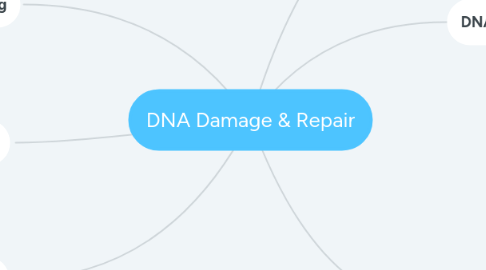
1. Proofreading
1.1. DNA polymerase proofreading is a spell-checking activity that enables DNA polymerases to remove newly made nucleotide incorporation errors from the primer terminus before further primer extension and also prevents translation synthesis.
1.1.1. Most of the mistakes during DNA replication are promptly corrected by proofreading. However, uncorrected mistakes may sometimes lead to serious consequences, such as cancer. Fortunately, most of the time, repair mechanisms correct the mistakes.
2. DNA Mismatch Repair System
2.1. Some errors are not corrected during replication, but are instead corrected after replication is completed; this type of repair is known as "mismatch repair".
2.1.1. DNA mismatch repair is a system for recognizing and repairing erroneous insertion, deletion, and mis-incorporation of bases that can arise during DNA replication and recombination, as well as repairing some forms of DNA damage. Mismatch repair is strand-specific.
3. Factors Affecting Proofreading
3.1. Mutations in 3' exonuclease domain
3.2. Ultraviolet radiation
3.3. Aging process
3.4. Epigenetics
4. DNA Replication
4.1. DNA replication is the process by which DNA makes a copy of itself during cell division. (A double stranded DNA molecule is copied to produce two identical DNA molecules)
4.1.1. There are 4 Main Steps of Replication:
4.1.1.1. Replication fork formation
4.1.1.2. Primer binding
4.1.1.3. Elongation
4.1.1.4. Termination
5. DNA Damage
5.1. DNA damage is a change in the basic structure of DNA that is not itself replicated when the DNA is replicated.
5.1.1. A DNA damage can be a chemical addition or disruption to a base of DNA (creating an abnormal nucleotide or nucleotide fragment) or a break in one or both chains.
6. Post-Replicative Efficiency
6.1. Mismatches must be corrected before the next round of replication
6.1.1. Consisting totally of undamaged DNA, and being temporary, mismatches give rise to a different type of DNA damage. If the annealed strands of the duplex get seperated, they no longer contain repairable damage → A mutation in 50% progeny DNA may occur due to the replication fork passing through a mismatch.
6.2. Coordinated action of mismatch binding proteins, exonuclease and endonuclease, ligases and DNA polymerases
6.2.1. Mismatched base pairs and unpaired loops which need the removal or re-synthesis of numerous nucleotides can be corrected by mismatch repair.
6.3. Polymerases supply proofreading exonuclease with a chance to remove the mispaired nucleotide from the newly created strand's 3' end
6.3.1. Having difficulty in extending from mispaired primer ends, polymerases provide this opportunity to exonucleases which are fundamental for replicative polymerases.
6.4. Distinguishing between the parent and daughter strands, the repair system must command the repair to the subsequent one
6.4.1. The mismatch recognition factor doesn’t know which of the strands contain the correct genetic data and which one carries the mutation when it spots a mismatch in DNA. As the correct genetic date is carried by the template strand, the process of repair must be directed to the mistaken, newly developed strand.
6.5. Post-translational modifications of PCNA
6.5.1. PCNA helps a wide range of proteins that take part in DNA replication and the repair of damage.
